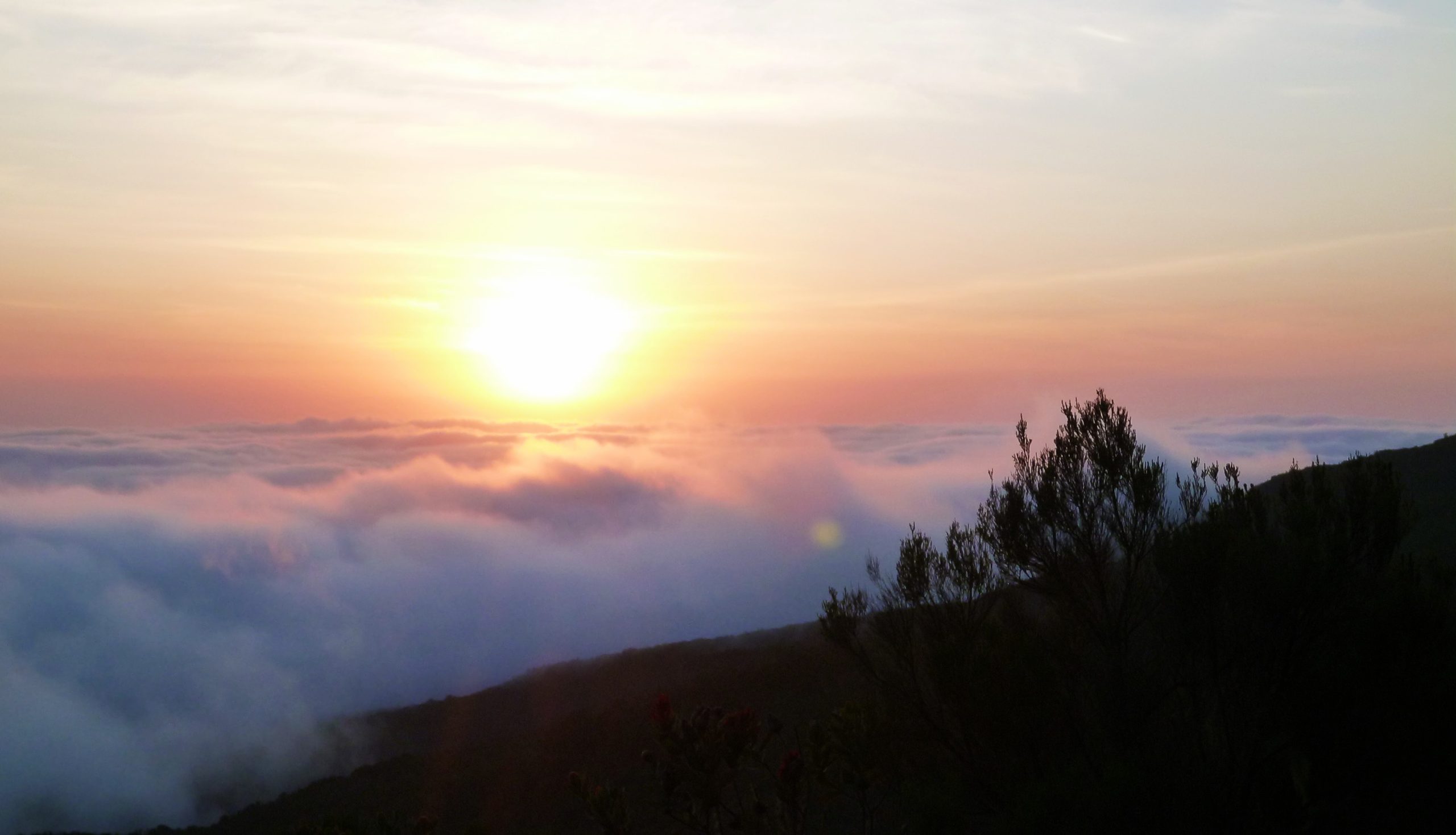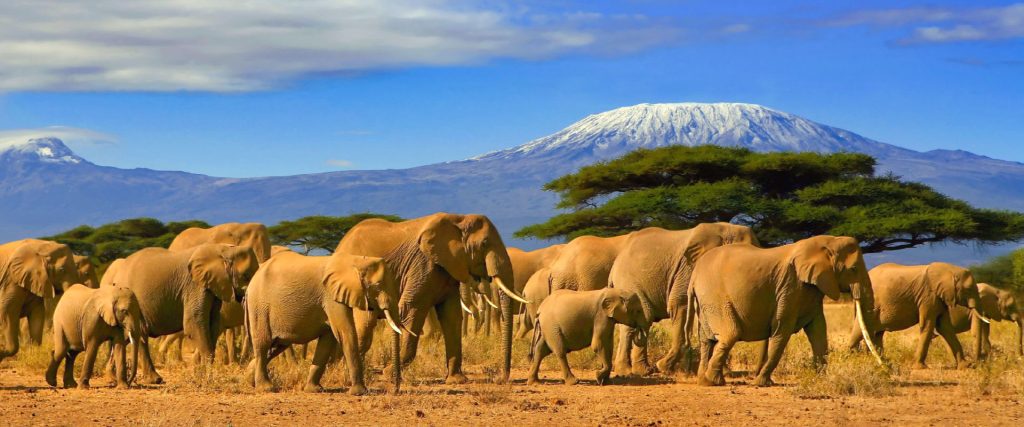
Climbing Kilimanjaro mountain: Everything You Need for the best African trekking Adventure
Mount Kilimanjaro, located in Tanzania, is the crown jewel of Africa, being the continent’s highest peak. Standing at a staggering 5,895 meters (19,341 feet), it is renowned for being the tallest free-standing mountain in the world. Climbers from around the world flock to Tanzania to conquer this natural wonder, which is considered one of the Seven Summits – the highest mountains on each continent.
This majestic mountain consists of three volcanic cones: Kibo, Mawenzi, and Shira, collectively forming the towering figure of Mount Kilimanjaro Peaks. The highest peak, Uhuru Peak, sits on Kibo’s crater rim, attracting adventurers who seek the ultimate trekking challenge. Whether you’re an avid trekker or a beginner, Mount Kilimanjaro Hiking Tours offer a variety of experiences that cater to different fitness levels and aspirations.
For those planning their adventure, finding the best climbing tour company which is Kilimanjaro Rwenzori Climbing experts to climb Kilimanjaro is essential for a successful and enjoyable experience. Numerous mountain Kilimanjaro trekking tours operate from Tanzania, offering expert guides, porters, and well-organized trek. This company provides all the essentials needed for your Mountain Kilimanjaro trekking and climbing tour in Africa .
Location of Mount Kilimanjaro
Tanzania’s Mount Kilimanjaro is a stunning volcanic massif located in northeastern Tanzania, near the border with Kenya. As the highest point in Africa, the Kilimanjaro peak rises to an impressive 19,340 feet (5,895 meters). It is situated about 100 miles (160 km) east of the East African Rift System and approximately 140 miles (225 km) south of Nairobi, Kenya. This majestic massif extends roughly east-west for 50 miles (80 km) and comprises three principal extinct volcanoes: Kibo (the center), Mawenzi (to the east), and Shira (to the west).
Kibo, being the youngest and highest of the three, maintains the classic form of a volcanic cone and crater. It is linked by a 7-mile (11-km) saddle at about 15,000 feet (4,500 meters) to Mawenzi, which stands at 16,893 feet (5,149 meters) and is the older core of a former summit. The Shira ridge, at 13,000 feet (3,962 meters), is a remnant of an earlier crater.
The breathtaking snow-clad dome of Kibo contains a caldera (crater) on its southern side that is 1.2 miles (2 km) across and approximately 980 feet (300 meters) deep. Within this caldera lies an inner cone that displays residual volcanic activity, making it a unique feature for those who climb Kilimanjaro. While Mawenzi’s cone is highly eroded, jagged, and split by gorges, only Kibo retains a permanent ice cap. Mawenzi features semi-permanent ice patches and substantial seasonal snow, enhancing the allure of mountain climbing in this region.
Mount Kilimanjaro hiking tours
If you’re considering hiking tours on Mount Kilimanjaro, it’s essential to choose from the best Kilimanjaro tour companies that offer comprehensive climbing tour packages, including Kilimanjaro trekking tours and Mt Kilimanjaro hiking tours. Exploring the climbing Kilimanjaro photos available online can provide insight into the stunning landscapes you will encounter during your adventure.
For those interested in the logistics, the cost to climb Mount Kilimanjaro varies based on the chosen itinerary and tour operator. It’s advisable to compare options among the best Mount Kilimanjaro tour operators and trek companies to find a package that suits your budget and experience level.
Whether you are embarking on a challenging trek or simply taking in the Kilimanjaro images and scenery, the experience of climbing Kilimanjaro in Tanzania will be unforgettable. Don’t forget to prepare adequately, as you’ll need to consider factors such as oxygen for mountain climbing at high altitudes.
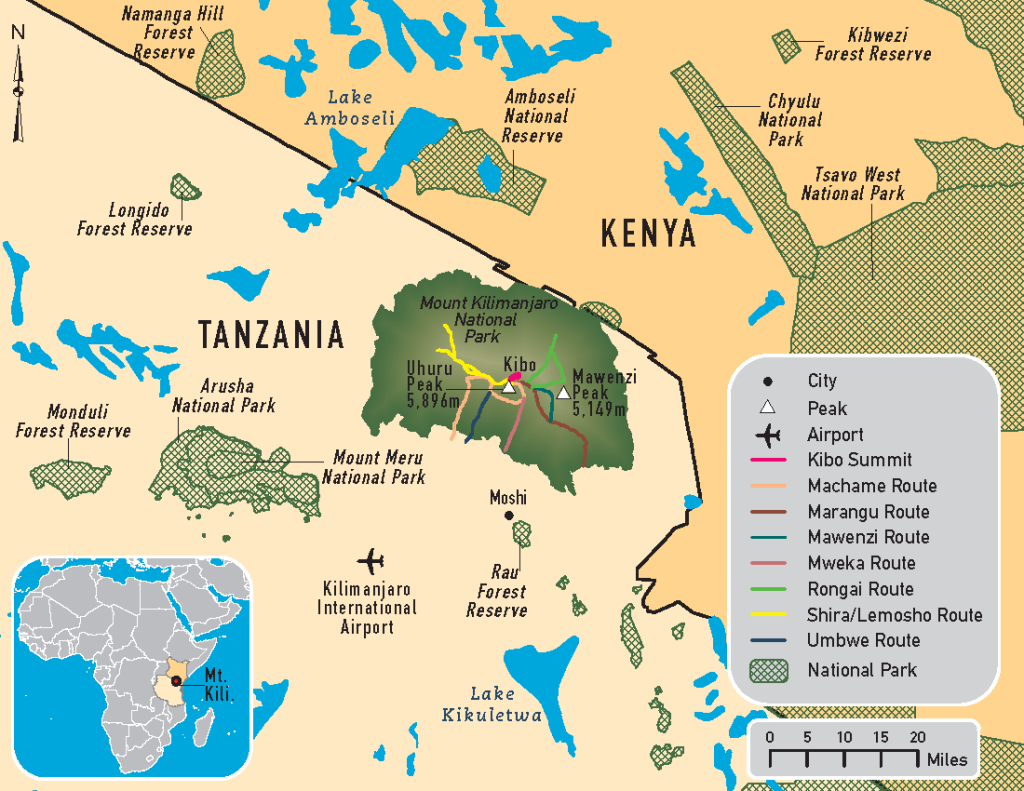
Mount Kilimanjaro’s Geological Marvels and Volcanic Cones
Mountain Kilimanjaro,Africa is more than just a trek; it’s a journey through time. Mount Kilimanjaro peaks are composed of three volcanic cones, each with its distinct features and history:
- Kibo: The highest and youngest of the three cones, Kibo houses Uhuru Peak – the highest point on Mount Kilimanjaro and the destination for most climbers. Although dormant, Kibo could theoretically erupt again, giving the summit an air of mystery and adventure.
- Mawenzi: Standing at 5,149 meters (16,893 feet), Mawenzi presents a more rugged, technical climb and is often admired from a distance by climbers on other routes.
- Shira: The oldest cone, now eroded into a broad plateau, offers beautiful scenery and is crossed by several routes. Its remnants serve as a reminder of Kilimanjaro’s ancient volcanic origins.
These geological wonders are part of the reason Kilimanjaro trekking tours are so popular among adventure seekers.
Ecological Zones and Climate on Mount Kilimanjaro
The climate of Mount Kilimanjaro in Africa, Tanzania offers an extraordinary journey through five different ecological zones:
- Cultivated Zone (800m – 1,800m): This region is home to the Chagga people, who have cultivated the fertile volcanic soils for generations, growing crops like bananas, coffee, and maize. Visitors to Mount Kilimanjaro often stop in local villages to experience the unique culture and sample the fresh produce.
- Rainforest Zone (1,800m – 2,800m): A lush, humid forest filled with exotic wildlife like blue monkeys, colobus monkeys, and many colorful birds. This zone is also one of the most photogenic areas of Kilimanjaro, perfect for capturing Kilimanjaro images.
- Moorland and Heath Zone (2,800m – 4,000m): As you ascend, the rainforest gives way to heathlands, with dramatic views, giant lobelias, and other unique plant species. This is the first point where the thinning air becomes noticeable, and trekkers begin to feel the altitude.
- Alpine Desert Zone (4,000m – 5,000m): A barren, windswept desert with little vegetation. This zone presents trekkers with stark landscapes and colder temperatures. Mount Kilimanjaro images captured here show the mountain’s raw, untamed beauty.
- Arctic Summit Zone (5,000m – 5,895m): The final stretch toward Uhuru Peak is a cold, glaciated landscape. The lack of oxygen and freezing temperatures challenge even the most experienced trekkers.
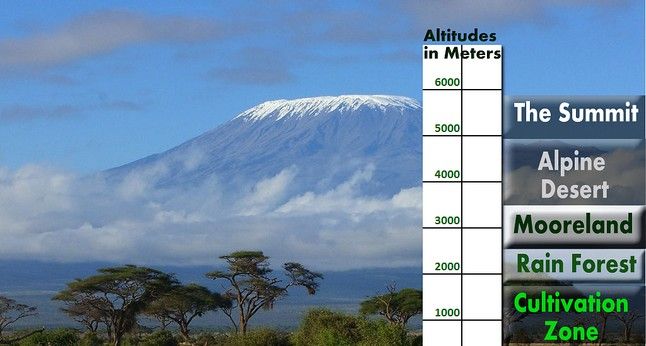
Facts About Mountain Kilimanjaro
Mount Kilimanjaro, standing proudly as the highest peak on the African continent, is a mesmerizing landmark that has captivated climbers and adventurers for centuries. Located in Tanzania, this majestic mountain holds numerous intriguing facts that add to its allure and mystique. From its unique geographical features to the challenging treks it offers, Tanzania Mount Kilimanjaro is an icon worth exploring, and many tourists fulfill this dream every year.
As a dormant volcano situated in Tanzania, Kilimanjaro gives travelers the confidence to visit and engage in various activities around it, as it has been decades since its last eruption. The mountain features three volcanic cones: Kibo, Mawenzi, and Shira. Notably, Kilimanjaro is the highest mountain in Africa, reaching an elevation of 19,341 feet (5,895 meters), making it the highest single free-standing mountain above sea level in the world.
For height lovers, climbing Kilimanjaro mountain is both challenging and achievable, offering breathtaking views and a once-in-a-lifetime experience. This sentiment rings true, given the high number of tourists who embark on Kilimanjaro hiking trips each year.
Africa’s Mountain Kilimanjaro holds significant cultural importance for local tribes, attracts a variety of wildlife, and serves as a crucial source of water, with several streams originating from it in Tanzania. Mountain Kilimanjaro has inspired countless literary works and has strict regulations for climbers and trekkers to protect its delicate ecosystem.
Mountain Kilimanjaro hiking tours, Africa
If you are considering climbing Kilimanjaro mountain, it’s important to select one of the best mountain Kilimanjaro tour companies or best Mount Kilimanjaro tour operators to ensure a safe and memorable adventure this case being Kilimanjaro Rwenzori Climbing experts. Exploring climbing Kilimanjaro photos online can provide you with visual motivation and insights into what to expect.
For those interested in mount Kilimanjaro hiking tours in Tanzania,Africa, it’s essential to understand the Mount Kilimanjaro climbing cost, as prices can vary based on our mountain Kilimanjaro our packages and operator. Whether you’re looking for mount Kilimanjaro hiking tours or specialized mount Kilimanjaro trekking tours in Africa, you will find options that suit various experience levels.
When preparing for your trek, consider factors such as the need for oxygen for mountain climbing at high altitudes. This will help ensure your safety and enjoyment during the ascent. With a variety of Mount Kilimanjaro tour packages available, you can tailor your adventure to fit your preferences.
Mode of Formation of Mount Kilimanjaro
As the highest mountain in Africa, Mount Kilimanjaro in Tanzania stands as one of the region’s most famous mountains known as the seven summits. While it’s perhaps best known for its breathtaking moun Kilimanjaro hikes and trails, Kilimanjaro mountain found in Tanzania, Africa also boasts a unique geography and history. The story of its formation dates back more than three million years—yes, that’s 3,000,000 years!
This famed mountain was born from the Great Rift Valley when Africa’s tectonic plates began to separate, a process explained by the theory of plate tectonism. These tectonic plates, which cover the Earth’s surface, are constantly shifting, leaving distinct geological markers in their wake.
When considering Mountain and Nubian Kilimanjaro and the Great Rift Valley, two African plates stand out: the Somalian Plate and the Nubian Plate. As the Somalian Plate drifted and pulled away from the Nubian Plate three million years ago, it led to the formation of the Greater Rift Valley. As the land shifted and the valley began to form, Kilimanjaro volcano was born. In this process, some portions of the Earth sank and depressed into the valley, while other sections shot upwards, forming volcanoes. Specifically, three volcanoes gave rise to Africa’s highest peak, Mount Kilimanjaro peak.
Mountain Kilimanjaro formation
This formation confirms that mountain Kilimanjaro was primarily created as a result of both tensional and compressional forces in the Earth’s crust. Among the world’s tallest mountains, Mount Kilimanjaro is renowned not only for its height but also for its geological significance. The mount Kilimanjaro summit and peak, known as Kibo Mountain, is the highest point on the mountain and a key destination for climbers and adventurers alike.
Whether you’re planning your mountain climbing tour to mountain Kilimanjaro in Tanzania, Africa or simply intrigued by its majestic presence, the history and formation of this iconic peak are as impressive as the mountain itself.
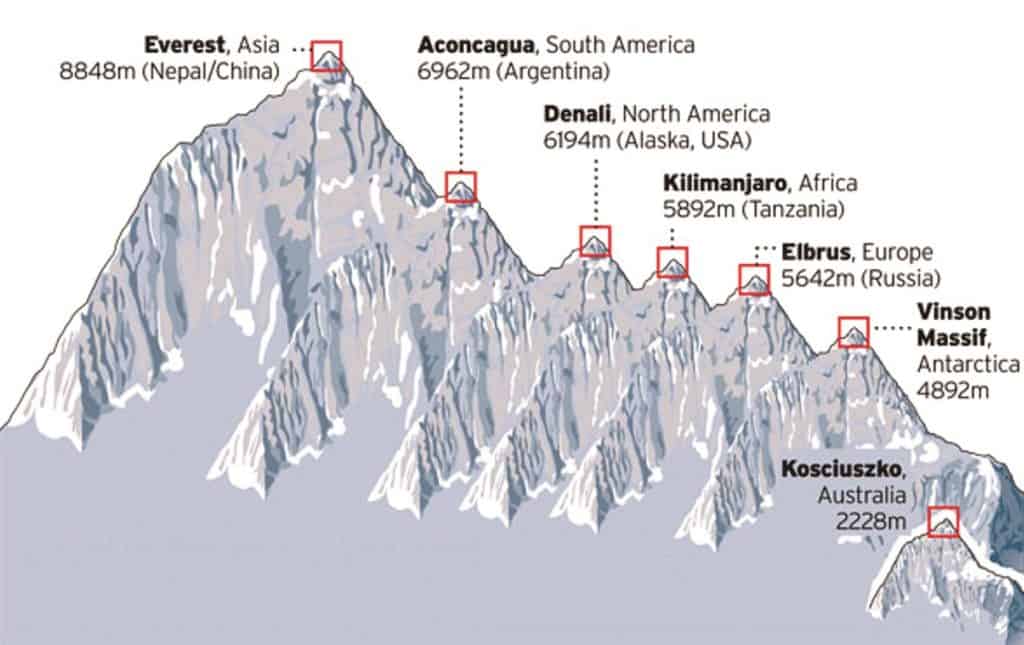
How to get to Mount Kilimanjaro
If you’re planning to climb Mount Kilimanjaro in Africa, your journey begins by flying into Kilimanjaro International Airport (JRO). This is the closest and most convenient airport for accessing Kilimanjaro in Tanzania,Africa. The airport’s IATA code is KIA, and it handles international flights from a number of major global hubs. Direct flights are available from Europe, such as Amsterdam and Zurich, as well as from the Middle East, including Doha and Istanbul, Turkey.
To get to mountain Kilimanjaro you need to fly to Kilimanjaro International Airport whose IATA code is KIA. There are several direct flights from Europe (fromAmsterdam and Zurich) and the Middle East (Doha and Turkey). But chances are you’ll need to fly via another African destination such as Dar es Salaam, Addis Ababa and Nairobi are your best bet.
From Julius Nyerere international airport, the road distance is approximately 63 miles, a distance that constitutes to roughly 2hrs and 1 minute of drive. This makes it so easy to access the mountain hence creating a full opportunity for our travelers to visit this gorgeous destination.
Getting to Mountain Kilimanjaro
For many travelers, connecting flights through other African cities are often necessary. Dar es Salaam, Addis Ababa, and Nairobi are common transit points with easy connections to Kilimanjaro. If you’re searching for airports near me for direct routes, the following airlines offer direct flights to Kilimanjaro International Airport (JRO):
- KLM Royal Dutch Airlines (from Amsterdam)
- Qatar Airways (from Doha)
- Turkish Airlines (from Istanbul)
- Ethiopian Airlines (from Addis Ababa)
- Kenya Airways (from Nairobi)
- RwandAir:(from Kigali )
- Precision Air: (from Nairobi)
For those flying into Julius Nyerere International Airport in Dar es Salaam, the road distance to Kilimanjaro is approximately 63 miles (100 kilometers), which takes about two hours by car. This makes it relatively easy to access the mountain and opens up exciting possibilities for travelers looking to explore this breathtaking destination.
If you’re searching for a flight to Tanzania in Africa, make sure to check for direct options or connecting flights to Kilimanjaro International Airport (JRO) for the quickest route to begin your adventure. Whether you’re coming from Europe, the Middle East, or other African countries, flying to Tanzania offers various choices for a seamless travel experience.
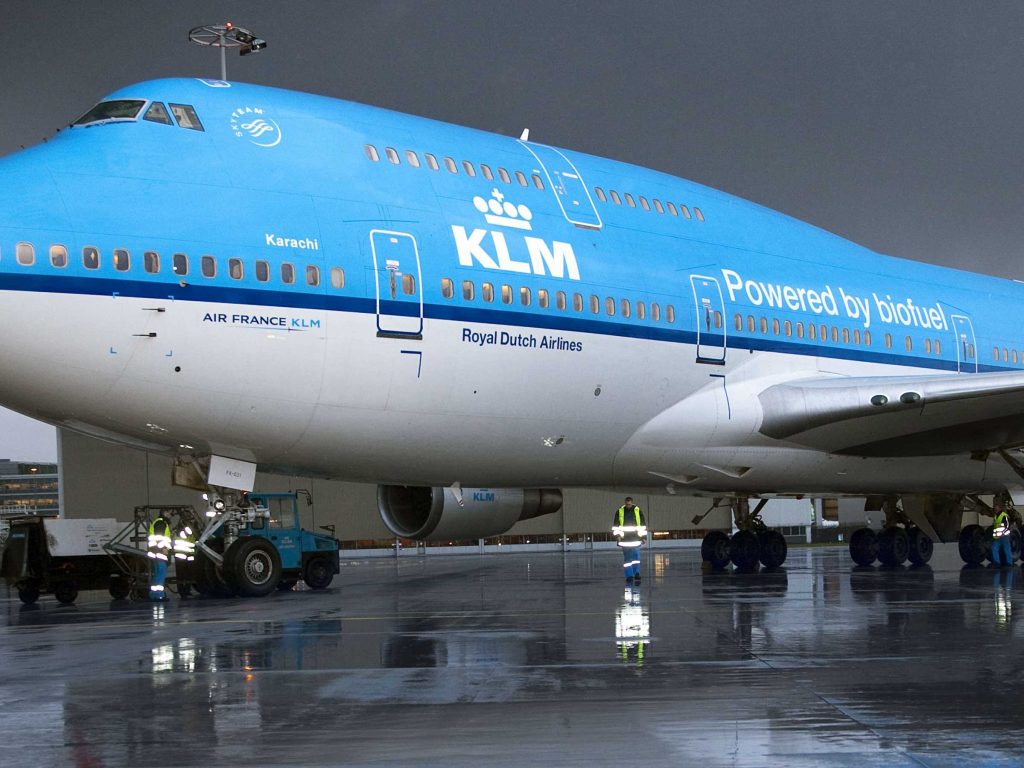
Why You Should Visit Mount Kilimanjaro at Least Once in a Lifetime
Mount Kilimanjaro, located in Tanzania, Africa, is a destination that attracts adventurers from around the globe. Climbing this iconic mountain, one of the largest peaks in the world, offers an unforgettable experience for various reasons, making it a must-do at least once in a lifetime.
- Climb Kilimanjaro for a Cause: One of the main reasons people are drawn to Mount Kilimanjaro in Tanzania, Africa is to climb it for a cause, charity, or awareness. Many climbers use the experience to raise money for causes such as cancer research or autism awareness. Even individuals with disabilities have climbed the mount Kilimanjaro peak, showing how physical limitations don’t have to stop you from achieving great things. The opportunity to combine adventure with a meaningful cause makes climbing mount Kilimanjaro a truly unique experience
- Climate Change Research: Among the thousands of people who visit Africa’s Mount Kilimanjaro, some come for scientific reasons. Researchers are studying the effects of climate change, with the mountain’s glaciers rapidly melting. Since 1912, 80% of Kilimanjaro’s snow peaks have disappeared, and scientists predict that its glaciers may vanish entirely by 2033. The mountain’s ecosystem serves as a living laboratory for those studying the world’s highest mountains.
- A Natural Wonder: Mount Kilimanjaro is a unique natural wonder. Located at the Earth’s equator, it is covered in snow at its tall peaks while being surrounded by lush green forests and vast savannahs. The mountain offers a range of climates and environments, making it one of the tallest mountain peaks in the world where you can experience both tropical forests and wintery snow within a single hike. You’ll also encounter rare plant species like the elephant flower and the Kilimanjaro tree—Africa’s tallest tree.
- Sense of Accomplishment: Climbing Mount Kilimanjaro peak is an immense personal achievement. Whether it’s for celebrating a graduation, marriage, or retirement, reaching the top of one of the world’s largest peaks is a milestone that you will never forget. Upon reaching Uhuru Peak, climbers can sign their names in a hidden notebook at the summit, marking their place in history.
More reasons to visit Mountain Kilimanjaro
- Fascinating Wildlife: As you hike Mount Kilimanjaro in Tanzania, Africa, you’ll encounter a range of fascinating wildlife. High-altitude birds and mammals live on the mountain, while its base is home to creatures like buck bucks, elands, baboons, and even rare species like black rhinos and honey badgers. This variety of wildlife adds to the mountain’s allure.
- Remote Yet Accessible: Despite its remote location near the Serengeti, Mount Kilimanjaro is highly accessible. Surrounding the mountain, you’ll find well-maintained infrastructure, including hotels, gear shops, and ground transportation. Along the trails, there are huts and designated areas for camping, providing hikers with comfort during their trek to the Kilimanjaro peak.
- Well-Maintained Trails: Kilimanjaro National Park is known for its cleanliness and well-maintained trails. Rangers ensure that no one leaves waste behind, making the park one of the best-preserved natural areas in the world. The mountain has a limited number of seven trails, and no roads cross it, preserving its natural beauty. Outhouses along the trail help to keep the area pristine.
- One of the Seven Summits: Mount Kilimanjaro is one of the Seven Summits—the tallest mountains on each of the seven continents. Compared to others, such as Mount Everest, it is considered one of the easier peaks to climb, requiring no technical mountaineering experience. People of various ages, from 6 to their mid-80s, have successfully reached its summit. However, preparation and awareness of the risks are crucial for a safe climb.
With all these remarkable reasons, climbing Kilimanjaro Tanzania should be on every adventurer’s bucket list. It’s more than just scaling one of the world’s tallest mountain peaks—it’s an opportunity to experience a true natural wonder.
What is the Best Time to Climb Mount Kilimanjaro
The best time to climb Mount Kilimanjaro is during the dry seasons from June to October and December to February, when the weather is most favorable. Mountain Kilimanjaro in Africa presents unique challenges in every season, but the dry months offer clearer skies, better trail conditions, and higher summit success rates. However, some trekkers prefer the quieter, greener months of the rainy season, when the crowds are fewer, and the mountain’s lower slopes burst with life.
Best Tour Companies to Climb Kilimanjaro
Choosing the best tour company to climb Kilimanjaro is one of the most crucial steps in planning your adventure. A top-tier company ensures safety, provides knowledgeable guides, and enhances the overall trekking experience. Here are some key factors to consider when selecting from the best Kilimanjaro tour companies:
- Experienced Guides: Look for companies with certified guides who have extensive knowledge of Kilimanjaro’s routes and can assist in preventing and managing altitude sickness.
- Safety Standards: The best companies provide high standards of safety, including oxygen tanks, portable altitude chambers, and well-trained medical personnel.
- Reputation and Reviews: Research online reviews and ratings to find companies with a proven track record of successful summits and excellent customer service.
We are the best Kilimanjaro tour company and also offer tailored Kilimanjaro trekking tours, including specialized itineraries that focus on mountain photography, wildlife spotting, or cultural experiences.
Accommodation Around Mount Kilimanjaro
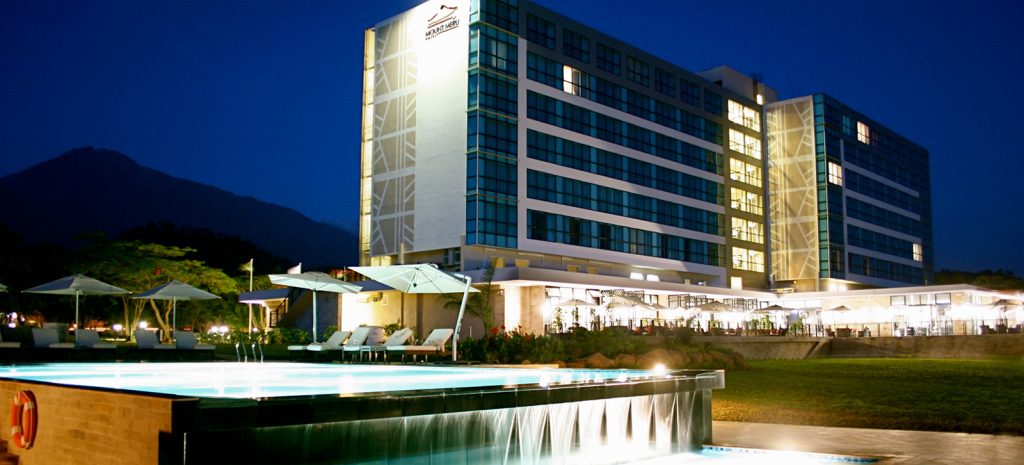
There are various accommodation options mostly hotels near Mount Kilimanjaro, ranging from budget-friendly guesthouses to luxury safari lodges and hotels. Many climbers choose to stay in mountain huts along the mount Kilimanjaro climbing routes, which offer basic accommodation and meals. For those looking for more comfort, you can find some of the best hotels in Moshi and hotels in Arusha Town, both of which provide easy access to Mount Kilimanjaro.
For a more luxurious stay, consider the Mount Meru Hotel in Arusha or one of the hotels in the mountains that offer breathtaking views of the landscape. Additionally, there are several hotels near Kilimanjaro that cater to all kinds of travelers, from solo adventurers to large groups.
Mountain Kilimanjaro tour team
Your local team on the climb of Kilimanjaro mountain will consist of a head guide, assistant guides, porters, and cooks. The Kilimanjaro hotel staff and climbing crew are known for their friendly and hardworking nature, especially the porters. It is important to be patient and respectful toward all staff members. Many guides and porters speak English well, although some porters may be trainees with limited English proficiency. Nevertheless, they are always eager to assist you in reaching the summit.
There is a porter to client ratio of 3:1 on all of our trips. Yes that’s three porters to every one of you! The Kilimanjaro National Park authorities recommend that each porter carry a maximum of 20kg for the company they are working for. However on Earths Edge expedition’s, porter welfare is paramount so we limit the weight allowance of your duffel bag to 15kg to ensure the porters are not overloaded.
Whether you’re looking for lodges near me, budget rooms and hotels, or the best hotels to relax after your climb, there are plenty of options to suit your needs when visiting Mount Kilimanjaro in Tanzania.
Popular Kilimanjaro Climbing Routes
Mount Kilimanajaro climbers have several routes to choose from when planning their Kilimanjaro trekking tours:
- Marangu Route: Known as the “Coca-Cola Route,” it’s the only route offering huts for accommodation, making it popular with beginners. It provides a gradual ascent but has the lowest success rate due to its short acclimatization period.
- Machame Route: The “Whiskey Route” is more scenic but challenging. It offers incredible views of Mount Kilimanjaro peaks and passes through diverse terrain. This is one of the most popular options for those seeking a balanced trekking experience.
- Lemosho Route: A less crowded, longer route that begins in the lush rainforest zone. It’s ideal for climbers who want a more immersive and gradual ascent, with ample opportunities to capture breathtaking Kilimanjaro images.
- Rongai Route: Approaching Kilimanjaro from the north, near the Kenyan border, this is one of the driest routes and is perfect for climbing during the wet season. It is less trafficked, offering a more serene trekking experience.
- Northern Circuit: The longest route, providing the best acclimatization and stunning views of Kilimanjaro Africa from every angle. Although it requires a longer time commitment, this route has the highest summit success rate.
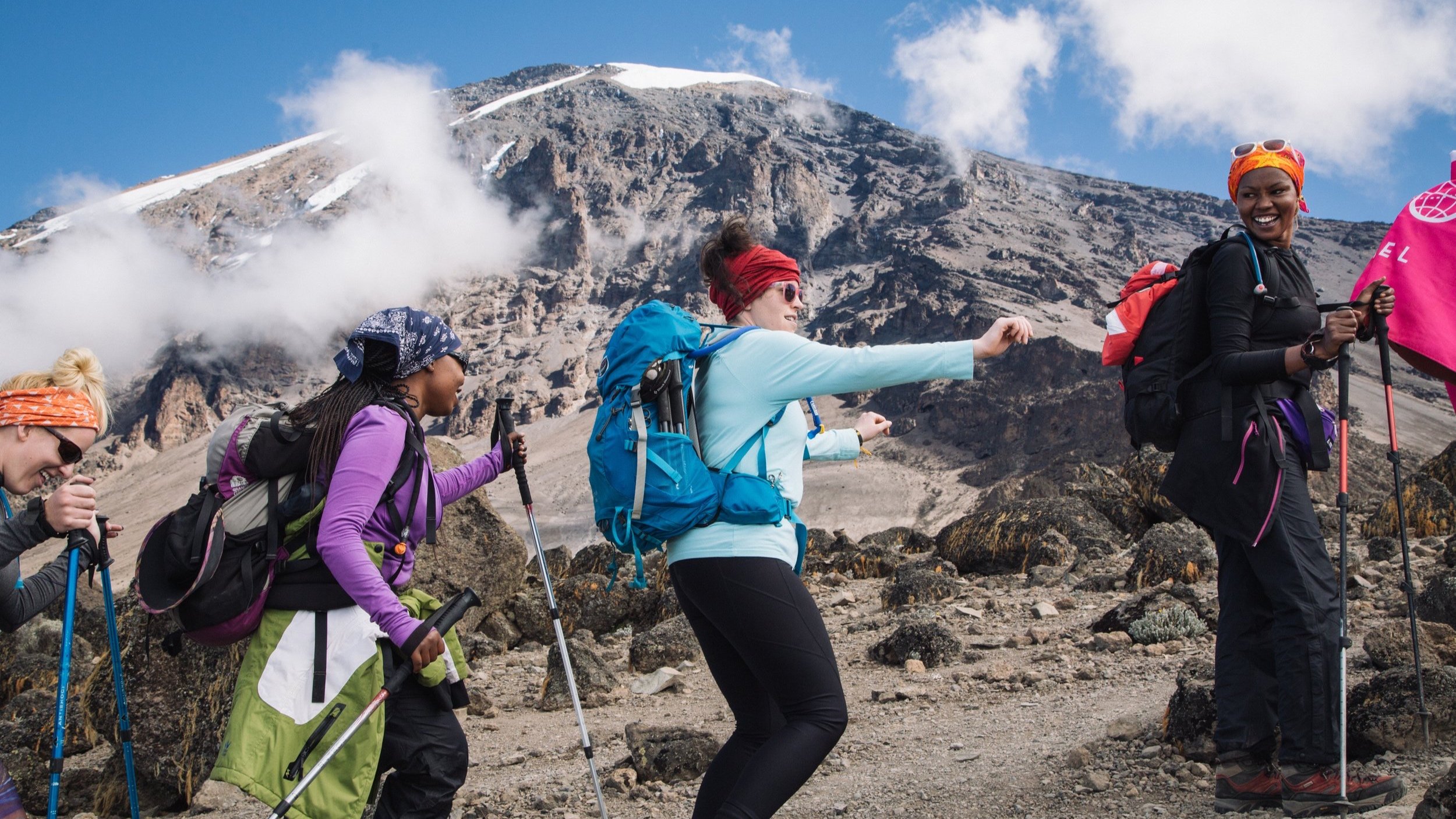
Challenges of Climbing mountain Kilimanjaro
Trekking Mount Kilimanjaro in Africa is a feat that comes with several challenges:
- Dehydration; these can lead to fatigue, dizziness,headaches, and even more severe health issues, so it’s essential to drinkplenty of fluids throughout the day
- Insufficient sleep; climbers do not get enough time to rest, inadequate rest can impair cognitive function and also increase the risk of altitude related illnesses.
- Climbing the barranco wall; this is one of the most exhilarating yet challenging sections of the climb is tackling the barranco wall, a steep rock face that demands both physical strength and mental fortitude hence a challenge.
- Experience rain, wind, hot, and cold temperature; climbers must be prepared to face rain, wind, and extreme fluctuations in temperature which may lead to sickness and weather challenges effectively.
- Lack of sleep to avoid developing the worst effects of altitude sickness which can also harm your brain to ensure that you have enough time to obtain a good night.
- The sun UV levels which are high so wear a protective clothing to avoid altitude sickness
- Hypoxia which is a deficiency in the amount of oxygen reaching the body’s tissues.
- Altitude Sickness: The biggest challenge for most trekkers is the risk of altitude sickness. Kilimanjaro’s rapid ascent means that many climbers are susceptible to Acute Mountain Sickness (AMS).
- Temperature Extremes: The varying climate zones mean trekkers experience everything from hot, humid conditions in the rainforest to freezing temperatures at the summit. Proper gear and layering are essential.
- Physical Stamina: While climbing Kilimanjaro doesn’t require technical mountaineering skills, it demands endurance and physical fitness. The summit day is particularly exhausting, often requiring trekkers to walk for 10 to 15 hours.
Kilimanjaro Climbing Tips and Packing List
Preparing for a Mount Kilimanjaro trek requires careful planning and the right equipment. Here’s a comprehensive packing list for your climb:
Trekking poles for balance and stability.
High-quality hiking boots that are already broken in.
Layered clothing: Including a warm down jacket, fleece, thermal layers, and a waterproof jacket.
Sleeping bag rated for cold temperatures.
Daypack with hydration system.
Sunscreen, sunglasses, and sun hat for protection from the sun’s intense rays at altitude.
Headlamp for night treks, particularly for summit night.
Snacks for energy during the long ascent.
These tips ensure a more comfortable climb and increase your chances of successfully summiting Uhuru Peak.
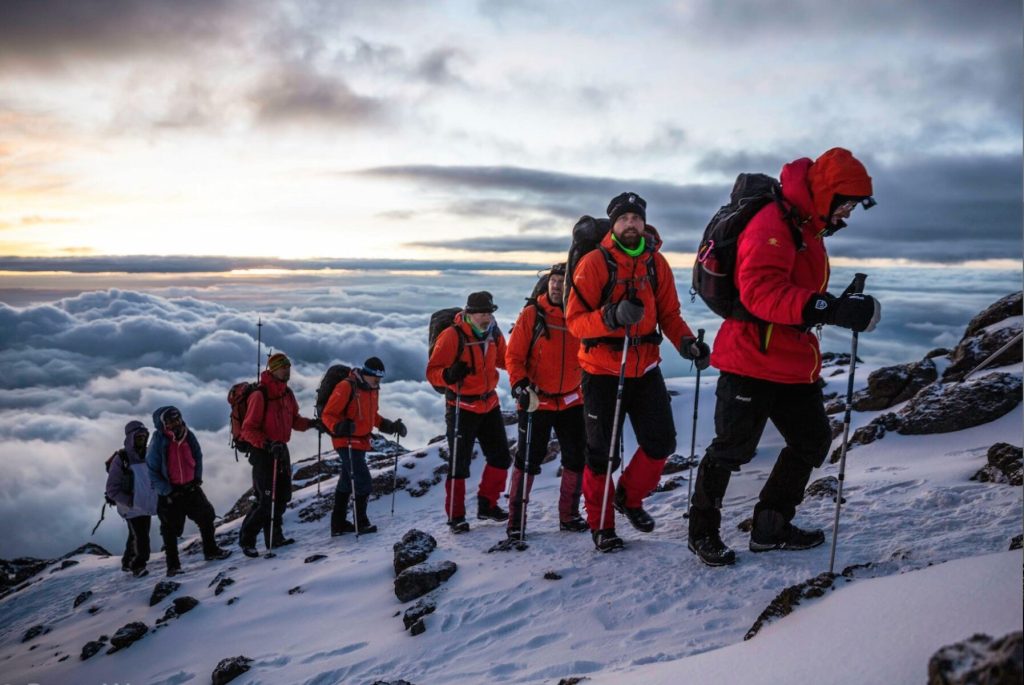
Wildlife and Nature on Kilimanjaro
Mount Kilimanjaro in Africa is not just about reaching the summit; it’s also about the wildlife and nature surrounding the mountain. The lower regions of the mountain are home to a variety of animals, including:
- Elephants and buffaloes in the rainforest zone.
- Monkeys, particularly the blue monkey and colobus monkey, are often seen swinging from the trees.
- Birdwatchers will delight in spotting species like the Malachite Sunbird, Hornbills, and the vibrant Turaco.
Beginner guide to climbing mountain Kilimanjaro
This section provides a detailed guide for beginners planning to climb Mount Kilimanjaro in Tanzania:
- Choose the right route: Select a route that matches your fitness level and experience.
- Acclimatize properly: Take your time to acclimatize to the altitude to reduce the risk of altitude sickness.
- Hire a reputable guide: A knowledgeable and experienced guide can provide valuable supportand advice.
- Pack appropriately: Bring essential gear and clothing to stay comfortable and safe.
- Prepare physically and mentally: Train for the climb and develop a positive mindset.
- Respect the environment: Leave no trace and follow park regulations.
- Enjoy the experience: Take time to appreciate the beauty of Mount Kilimanjaro and the journey to the
summit.
Acceptance while climbing Kilimanjaro mountain
Climbing Mount Kilimanjaro is a transformative experience that can be both physically and mentally challenging. Be prepared for the physical demands of the mount Kilimanjaro climb and to have a positive mindset. Accepting the challenges and embracing the mountain Kilimanjaro trekking tour are key to reaching the summit.
